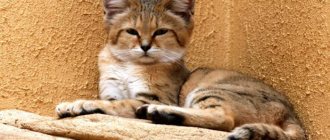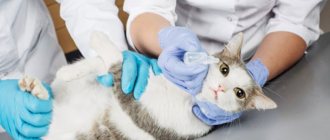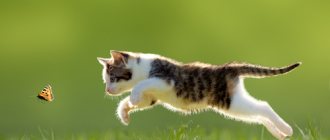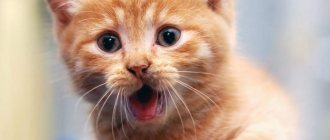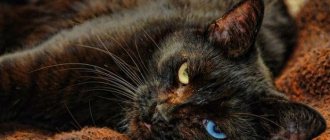Why does a cat need mustaches and eyebrows?
Why does a cat need whiskers? They are an important organ of touch. Many animals that feed on their mother's milk have similar adaptations.
The hardest and longest whiskers of a cat help the animal navigate in space. These hairs are located on the cheeks, on both sides of the nose, above the eyes, on the chin and tail.
Such whiskers perform an important function due to the fact that there are sensitive endings at the tip of each whisker. The function of the whiskers is to transmit information about the surrounding world to the pet’s brain. This is how the cat knows when an obstacle or prey appears in its path.
What are whiskers called on cats?
Cat's whiskers also have another name that is not known to everyone. Scientifically, they are called vibrissae. Cats touch different objects with them to determine their size. For example, before climbing into a hole, a cat checks with whiskers whether it is of sufficient size.
Do hairless cats have whiskers?
The pet may not have them at all. Due to the nature of the breed, hairless cats may have broken whiskers, curled or not have them at all.
Sometimes the absence of vibrissae occurs in furry representatives of the cat family. This is due not only to the breed, but also to a kind of mutation.
Whiskers on a cat's paws and nose
As already mentioned, the whiskers of cats are located not only on the face, but also on the paws and tail. How many whiskers a cat has along the body depends on the breed and the specific representative.
The longest hairs on the nose reach seven centimeters. The Book of Records has registered a Maine Coon cat in Finland with whiskers nineteen centimeters long. Another Russian cat had a slightly shorter whisker length - only 13.5 centimeters.
The whiskers on the paws and tail are not so long; they can be distinguished by their greater rigidity. The number of rows of a cat's whiskers determines how well they navigate the world around them.
What are cat whiskers - vibrissae?
In addition to the familiar sense organs, such as eyes and ears, the cat also has specific organs - whiskers, called whiskers by zoologists. They are long, dense hairs located at the base of the animal's nose.
© shutterstock
At the same time, the whisker follicles themselves are surrounded by muscle tissue with many nerve endings, which allows the pet to move them, which greatly simplifies the collection of information from the surrounding world. The developed nervous tissue surrounding the whiskers makes it possible to most accurately and clearly transmit impulses to the brain, thanks to which the cat can use their functions to the fullest.
A cat's whiskers can not only be cut off, but also fall out and break. At the same time, they almost always grow back stronger and more renewed. The mustache will not grow back only if its follicles have been damaged. Basically, it takes about a month to restore the vibrissae.
Why does a kitten's whiskers break?
If a pet's whiskers, especially small ones, break off, this can cause anxiety for the owners. The reasons for this phenomenon may be different:
- a cat's whiskers break during adolescence;
- when the balance of minerals in the body is disturbed;
- the reason may be the presence of worms or fungal infections in the pet’s body;
- damage to the vibrissae during play;
- Sometimes the antennae of small kittens are broken by mother cats to prove their authority to the kittens.
The reason could also be that the kitten is too curious - it came too close to the fire or met another animal.
Adult cats and male cats also often lose their whiskers; this may be due to the following factors:
- An allergic reaction to an external or internal irritant.
- A cat loses whiskers if the air in the room is too dry.
- Vibrissae can break due to hormonal imbalance or improper functioning of the thyroid gland. In this case, the cat may be left without a whisker altogether.
- A cat's whiskers split if it eats the wrong or unbalanced food.
- Domestic cats lose their whiskers due to kidney problems and dehydration.
What to do to stop vibrissae loss
First of all, if your cat's whiskers are falling out, you should take him to the vet for an examination. The doctor will examine the pet and, if necessary, prescribe appropriate tests. Only after the reason why the cat’s whiskers break is determined, treatment is prescribed.
As a rule, in case of hair loss, the animal is prescribed anti-parasitic drugs, anti-allergenic drugs, antibiotics, and vitamins. You will also need to normalize the pet’s living conditions, change the cat’s diet, and, if necessary, increase the air humidity in the house.
Vibrissae
This is the scientific name for the hair on your pet's face. Speaking about why a cat needs a mustache, it is important to note that zoologists have studied this issue quite closely, and today there are well-founded answers. Vibrissae are a sixth sense organ that has a connection with the brain. One can only regret that you and I are deprived of such a tool. You can already say what will happen if you cut off a cat’s whiskers. This is about the same as if he were deprived of an eye, ear or nose. The brain will not be able to receive important signals and respond to them properly.
Why do cats' whiskers turn black or white?
The color of the whiskers directly depends on the color of the animal itself. They can be white, black, red or several colors at the same time. Usually a black cat has black whiskers, but sometimes white whiskers are normal. In some breeds they turn black over time.
If a cat with a white mustache has acquired a black color, this phenomenon also does not mean anything terrible, just a normal change in hair pigmentation. You should be wary if the color, on the contrary, changes to white. Sometimes this can be a symptom of a disease. Therefore, even with a slight deviation, it is worth consulting with a veterinarian.
What and why
It’s not for nothing that even in fairy tales it was emphasized: mustachioed and striped. Gorgeous long whiskers are a source of pride for a cat, and often for its owners. Yes, nature gave them for a reason. Let's first look at why a cat needs a mustache. In addition to their decorative function, they are also an organ of smell. They even have a second name, which is rarely mentioned in everyday life.
Consequences of losing a mustache
When caring for an animal, you should not trim or pull out broken whiskers. The procedure will only worsen short-range navigation skills. If a domestic cat's whiskers are trimmed, this will not have a negative impact on its health. The animal will still have a sense of smell and touch, but its orientation will become worse. The loss of sensory sensors is difficult for street cats who are forced to find their own food to cope with.
Complete renewal of lost whiskers in a healthy cat occurs within 3 months.
Possible consequences of losing a mustache:
- Partial disorientation. Your pet can get hurt if it collides with a foreign object at night.
- Loss of the skill to measure the distance between objects. An animal often gets stuck in a hole in a fence, for example, having failed to correctly calculate its dimensions and the dimensions of the opening.
- Deterioration in jumping ability. Due to a decrease in the computational function, the cat sometimes does not jump or, conversely, flies over the intended target.
- Increased injury rate. A cat sometimes loses an eye while walking through bushes. Due to the absence of vibrissae, the animal cannot close its eyes in time.
- Behavioral changes. Fearfulness, inappropriate actions, loss of interest in games and active pastime.
One of the consequences of the loss of whiskers is a recumbent lifestyle
Differences from animal hairs
There are physiological characteristics. The vibrissae are planted very deep into the skin; these are not ordinary hairs at all. Each whisker is an antenna that is surrounded by nerve cells. This is necessary to transmit signals directly to the brain center. But that is not all. Vibrissae are equipped with muscle fibers.
That is, it is not hair at all, but rather complex receptors. In fact, they are responsible for the sense of smell, they just changed during evolution. The longest and most sensitive mustaches are located on top, shorter ones can be seen in the chin area. Remember that cats hunt at night, they need to quickly and silently find and catch a rodent. It is thanks to the whiskers that a cat can feel an object without contacting it and avoid colliding with an obstacle. What happens if you cut a cat's whiskers? He will lose a huge flow of information. Of course, this is not fatal at home, but it affects the well-being of the pet.
Symptoms
- In case of infectious diseases, in addition to the wound around the mouth, ulcerations of the mucous membranes of the mouth, vagina, prepuce, and nasal planum may be present. Hypersalivation (excessive salivation), lethargy, systemic temperature may increase, and refusal to feed are often present.
- With chemical, thermal burns and trauma, there is severe pain. The oral cavity is also often damaged. And there is medical history data that can immediately help with the diagnosis, for example, if the cat chewed a houseplant the day before.
- An indolent ulcer usually looks very scary. The lip swells greatly and becomes dense. However, there is no pain when touching the area unless there is a secondary infection. And the problem itself is easily treatable.
- Oncology usually develops over a long period of time. The elderly age of the pet may also be a reason to think about it.
- Uremic ulcers are most common in the mouth, but can also occur around the mouth. Occurs in animals with renal failure. As a rule, animals are thinner, have poor coat quality, and poor appetite .
Watch the video: Rhinotracheitis in cats, treatment. Veterinarian gives advice
Causes and mechanism of disease development
The reason for the failure of the keratinization process of epidermal cells in cats has not been established. Therefore, experts identify several factors that contribute to this phenomenon and lead to the appearance of black spots on the fur of cats. These include:
- increased secretion from the sebaceous glands of the epidermis;
- sticking of food debris to the beard or skin on the cat’s chin;
- decreased immunity after severe infectious diseases, as well as during the rehabilitation period after injuries or operations;
- dysfunction of the endocrine glands;
- intoxication phenomena caused by diseases of the gastrointestinal tract, liver and pancreas;
- allergic reactions;
- skin pathologies;
- dermatophytoses;
- demodicosis;
- improper care of the animal's skin and fur;
- some infectious and parasitic diseases;
- severe or prolonged stress.
Important! Owners must carefully monitor the cleanliness and integrity of the dishes from which the animal eats and drinks. Pathogenic microorganisms accumulate in chips, scratches and cracks, then enter the pet’s skin and can easily provoke inflammation and cause sores on the chin of cats.
The mechanism of comedones formation in cats occurs in 5 stages:
- Increased secretion from the sebaceous glands (sebum).
- Blockage of the ducts of the sebaceous glands with a mixture of sebum and dead epithelial cells.
- Formation of open cysts (comedones) at the mouth of the hair follicle.
- Oxidation of the contents of comedones in the presence of oxygen. Visually, this is marked by the appearance of black dots on the cat’s skin.
- Opening of comedones.
If comedones open into the external environment during injury by an animal, infection occurs and purulent inflammation develops. But sometimes cysts greatly increase in size, become inflamed and open into the dermal cavity. In this case, surrounding tissues are involved in the process. The cat's immune system tries to prevent the spread of pathogenic microflora and releases a huge number of white blood cells. When they die, they form purulent exudate, which accumulates in the internal cavity and then tends to come out. Clinically, this is manifested by the formation of abscesses, severe itching and even pain. Scratching the abscess leads to secondary infection, the formation of non-healing ulcers, which, when dry, form scabs on the cat’s chin.
Important! Attempts by cat owners to open comedones or abscesses on their own without following antiseptic rules often lead to re-infection and the development of complications.
Why do pigeons walk and sparrows jump?
First of all, the method of movement depends on the size of the bird: a large individual will not jump, because when jumping, the load on the joints and ligaments increases sharply. But this rule does not apply to all birds: the small wagtail runs on the ground, and the magpie moves by jumping.
The fact is that the method of movement depends on the way of life: sparrows and magpies, which spend most of their time in the crowns of trees and bushes, jump because it is easier to move among the branches, and pigeons, which use branches only as a perch, prefer to walk or running.

